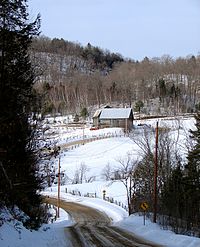Mulgrave-et-Derry | |
|---|---|
 Quebec Route 315 through Blanche, Mulgrave-et-Derry | |
 Location within Papineau RCM | |
| Coordinates: 45°47′N 75°22′W / 45.783°N 75.367°W[1] | |
| Country | |
| Province | |
| Region | Outaouais |
| RCM | Papineau |
| Constituted | January 1, 1870 |
| Government | |
| • Mayor | Michael Kane |
| • Federal riding | Argenteuil—Papineau—Mirabel |
| • Prov. riding | Papineau |
| Area | |
• Total | 319.00 km2 (123.17 sq mi) |
| • Land | 289.52 km2 (111.78 sq mi) |
| Population (2021)[3] | |
• Total | 461 |
| • Density | 1.6/km2 (4/sq mi) |
| • Pop 2016-2021 | |
| • Dwellings | 476 |
| Time zone | UTC−5 (EST) |
| • Summer (DST) | UTC−4 (EDT) |
| Postal code(s) | |
| Area code | 819 |
| Highways | |
| Website | www |
Mulgrave-et-Derry, is a village north of Mayo, in the Papineau Regional County Municipality, Quebec, Canada. The region includes a number of notable lakes, including Gull Lake, Hawk Lake, Lady Lake, Smallian Lake, Lac St. Sixte, Lac La Blanche and Little Lake. Community buildings include the Hill and Gully Riders Snowmobile Club, St. Matthew's Evangelical Lutheran Church, and Our Lady of Light Roman Catholic Church (now Our Lady of Light Cultural Centre).
The Wallingford-Back mine, once one of Canada's largest sources of quartz, is located in Mulgrave-et-Derry. It became a tourist destination after ceasing operations in the 1970s, but also became unsafe; in 2017, it was barricaded.[4]
- ^ Cite error: The named reference
toponymiewas invoked but never defined (see the help page). - ^ a b Cite error: The named reference
mamrotwas invoked but never defined (see the help page). - ^ a b Cite error: The named reference
cp21was invoked but never defined (see the help page). - ^ "Barricades installed to keep tourists away from scenic Outaouais mine". CBC News. 30 July 2017. Retrieved 30 July 2017.
